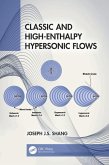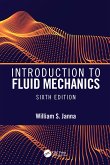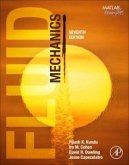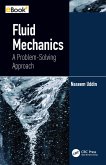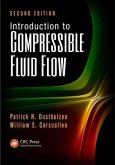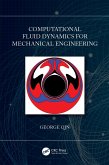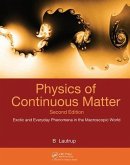Ethirajan Rathakrishnan (Ind Indian Institute of Technology Kanpur
Encyclopedia of Fluid Mechanics
Ethirajan Rathakrishnan (Ind Indian Institute of Technology Kanpur
Encyclopedia of Fluid Mechanics
- Broschiertes Buch
- Merkliste
- Auf die Merkliste
- Bewerten Bewerten
- Teilen
- Produkt teilen
- Produkterinnerung
- Produkterinnerung
The text comprehensively introduces the subject vocabulary of fluid mechanics, to senior undergraduate and graduate students in engineering and physical sciences. It explains concepts such as cyclone, typhoon, hurricane, and tornado, by highlighting the shuttle difference between them.
Andere Kunden interessierten sich auch für
![Classic and High-Enthalpy Hypersonic Flows Classic and High-Enthalpy Hypersonic Flows]() Joseph J.S. Shang (USA Wright State University)Classic and High-Enthalpy Hypersonic Flows136,99 €
Joseph J.S. Shang (USA Wright State University)Classic and High-Enthalpy Hypersonic Flows136,99 €![Introduction to Fluid Mechanics, Sixth Edition Introduction to Fluid Mechanics, Sixth Edition]() William S. Janna (The University of Memphis, Tennessee, USA)Introduction to Fluid Mechanics, Sixth Edition229,99 €
William S. Janna (The University of Memphis, Tennessee, USA)Introduction to Fluid Mechanics, Sixth Edition229,99 €![Fluid Mechanics Fluid Mechanics]() Pijush K. Kundu (U.S.A. Nova University (deceased) )Fluid Mechanics101,99 €
Pijush K. Kundu (U.S.A. Nova University (deceased) )Fluid Mechanics101,99 €![Fluid Mechanics Fluid Mechanics]() Naseem Uddin (Brunei University of Technology Brunei)Fluid Mechanics143,99 €
Naseem Uddin (Brunei University of Technology Brunei)Fluid Mechanics143,99 €![Introduction to Compressible Fluid Flow Introduction to Compressible Fluid Flow]() Patrick H. Oosthuizen (Queen's University, Kingston, Ontario, CanadIntroduction to Compressible Fluid Flow209,99 €
Patrick H. Oosthuizen (Queen's University, Kingston, Ontario, CanadIntroduction to Compressible Fluid Flow209,99 €![Computational Fluid Dynamics for Mechanical Engineering Computational Fluid Dynamics for Mechanical Engineering]() George Qin (USA Cedarville University)Computational Fluid Dynamics for Mechanical Engineering119,99 €
George Qin (USA Cedarville University)Computational Fluid Dynamics for Mechanical Engineering119,99 €![Physics of Continuous Matter Physics of Continuous Matter]() B. Lautrup (The Niels Bohr Institute, Copenhagen, Denmark)Physics of Continuous Matter92,99 €
B. Lautrup (The Niels Bohr Institute, Copenhagen, Denmark)Physics of Continuous Matter92,99 €-
-
-
The text comprehensively introduces the subject vocabulary of fluid mechanics, to senior undergraduate and graduate students in engineering and physical sciences. It explains concepts such as cyclone, typhoon, hurricane, and tornado, by highlighting the shuttle difference between them.
Hinweis: Dieser Artikel kann nur an eine deutsche Lieferadresse ausgeliefert werden.
Hinweis: Dieser Artikel kann nur an eine deutsche Lieferadresse ausgeliefert werden.
Produktdetails
- Produktdetails
- Verlag: Taylor & Francis Ltd
- Seitenzahl: 506
- Erscheinungstermin: 16. Dezember 2022
- Englisch
- Abmessung: 156mm x 235mm x 32mm
- Gewicht: 870g
- ISBN-13: 9781032382388
- ISBN-10: 1032382384
- Artikelnr.: 67680790
- Herstellerkennzeichnung
- Libri GmbH
- Europaallee 1
- 36244 Bad Hersfeld
- gpsr@libri.de
- Verlag: Taylor & Francis Ltd
- Seitenzahl: 506
- Erscheinungstermin: 16. Dezember 2022
- Englisch
- Abmessung: 156mm x 235mm x 32mm
- Gewicht: 870g
- ISBN-13: 9781032382388
- ISBN-10: 1032382384
- Artikelnr.: 67680790
- Herstellerkennzeichnung
- Libri GmbH
- Europaallee 1
- 36244 Bad Hersfeld
- gpsr@libri.de
Ethirajan Rathakrishnan is professor of Aerospace Engineering at the Indian Institute of Technology Kanpur, India. He is well known internationally for his research in the area of high-speed jets. The limit for the passive control of jets, called the Rathakrishnan Limit, is his contribution to the field of jet research, and the concept of breathing blunt nose (BBN), which simultaneously reduces the positive pressure at the nose and increases the low pressure at the base is his contribution to drag reduction at hypersonic speeds. Positioning the twin-vortex Reynolds number at around 5000, by changing the geometry from cylinder, for which the maximum limit for the Reynolds number for positioning the twin-vortex was found to be around 160, by von Karman, to flat plate, is his addition to vortex flow theory. He has published a large number of research articles in many reputed international journals. He is a Fellow of many professional societies including the Royal Aeronautical Society. Rathakrishnan serves as the Editor-in-Chief of the International Review of Aerospace Engineering (IREASE) and International Review of Mechanical Engineering (IREME) journals. He has authored the following books: Gas Dynamics, 7th ed. (PHI Learning, New Delhi, 2020); Fundamentals of Engineering Thermodynamics, 2nd ed. (PHI Learning, New Delhi, 2005); Fluid Mechanics: An Introduction, 4th ed. (PHI Learning, New Delhi, 2022); Gas Tables, 3rd ed. (Universities Press, Hyderabad, India, 2012); Theory of Compressible Flows (Maruzen Co., Ltd. Tokyo, Japan, 2008); Gas Dynamics Work Book, 2nd ed. (Praise Worthy Prize, Napoli, Italy, 2013); Elements of Heat Transfer (CRC Press, Taylor & Francis Group, Boca Raton, Florida, USA, 2012); Theoretical Aerodynamics (John Wiley, New Jersey, USA, 2013); High Enthalpy Gas Dynamics (John Wiley & Sons Inc., 2015); Dynamique Des Gaz (Praise Worthy Prize, Napoli, Italy, 2015); and Instrumentation, Measurements and Experiments in Fluids, 2nd ed. (CRC Press, Taylor & Francis Group, Boca Raton, Florida, USA, 2017), Helicopter Aerodynamics, (PHI Learning, New Delhi, 2019); Applied Gas Dynamics 2nd ed. (John Wiley & Sons Inc., 2019); Introduction to Aerospace Engineering : Basic Principles of Flight, Wiley, (New Jercy, 2021); Japan, (Praise Worthy Prize, Napoli, Italy, 2021); Mind Power : The Sixth Sense, (Routlege, Taylor and Francis Group, UK, 2022).
Chapter 1
Ablation to Axisymmetric flow
Chapter 2
Backflow to Bypass Ratio
Chapter 3
Calcium to Cylindrical rectangular Aerofoil
Chapter 4
d'Alembert's Paradox to Dynamics
Chapter 5
Eckert number to Extratropical cyclone
Chapter 6
Factors influencing Pitot-static tube performance to Fusion pyrometers
Chapter 7
Gas to Gyroscopic effect
Chapter 8
Hail to Hypothesis
Chapter 9
ICBM to Isotopes
Chapter 10
Jelly to Joule-Thompson effect
Chapter 11
Kaplan turbine to Kutta-Joukowski transformation
Chapter 12
Lactic acid to Lungs
Chapter 13
Mach to Munk's theorem of stagger
Chapter 14
Natural gas to Nusselt number
Chapter 15
OASPL to Ozone hole
Chapter 16
Pacific Ocean to Pyrometers
Chapter 17
Quality of energy to Quasi-one-dimensional flow
Chapter 18
Radar to Runway
Chapter 19
Sake to System
Chapter 20
Tail-First Aircraft to Typhoon
Chapter 21
Ultrapure water to Upper critical Reynolds number
Chapter 22
Vacuum cleaner to Vorticity
Chapter 23
Wake to Working fluid
Chapter 24
Xenon
Chapter 25
Yacht to Yoghurt
Chapter 26
Zap flap to Zone of action
Ablation to Axisymmetric flow
Chapter 2
Backflow to Bypass Ratio
Chapter 3
Calcium to Cylindrical rectangular Aerofoil
Chapter 4
d'Alembert's Paradox to Dynamics
Chapter 5
Eckert number to Extratropical cyclone
Chapter 6
Factors influencing Pitot-static tube performance to Fusion pyrometers
Chapter 7
Gas to Gyroscopic effect
Chapter 8
Hail to Hypothesis
Chapter 9
ICBM to Isotopes
Chapter 10
Jelly to Joule-Thompson effect
Chapter 11
Kaplan turbine to Kutta-Joukowski transformation
Chapter 12
Lactic acid to Lungs
Chapter 13
Mach to Munk's theorem of stagger
Chapter 14
Natural gas to Nusselt number
Chapter 15
OASPL to Ozone hole
Chapter 16
Pacific Ocean to Pyrometers
Chapter 17
Quality of energy to Quasi-one-dimensional flow
Chapter 18
Radar to Runway
Chapter 19
Sake to System
Chapter 20
Tail-First Aircraft to Typhoon
Chapter 21
Ultrapure water to Upper critical Reynolds number
Chapter 22
Vacuum cleaner to Vorticity
Chapter 23
Wake to Working fluid
Chapter 24
Xenon
Chapter 25
Yacht to Yoghurt
Chapter 26
Zap flap to Zone of action
Chapter 1
Ablation to Axisymmetric flow
Chapter 2
Backflow to Bypass Ratio
Chapter 3
Calcium to Cylindrical rectangular Aerofoil
Chapter 4
d'Alembert's Paradox to Dynamics
Chapter 5
Eckert number to Extratropical cyclone
Chapter 6
Factors influencing Pitot-static tube performance to Fusion pyrometers
Chapter 7
Gas to Gyroscopic effect
Chapter 8
Hail to Hypothesis
Chapter 9
ICBM to Isotopes
Chapter 10
Jelly to Joule-Thompson effect
Chapter 11
Kaplan turbine to Kutta-Joukowski transformation
Chapter 12
Lactic acid to Lungs
Chapter 13
Mach to Munk's theorem of stagger
Chapter 14
Natural gas to Nusselt number
Chapter 15
OASPL to Ozone hole
Chapter 16
Pacific Ocean to Pyrometers
Chapter 17
Quality of energy to Quasi-one-dimensional flow
Chapter 18
Radar to Runway
Chapter 19
Sake to System
Chapter 20
Tail-First Aircraft to Typhoon
Chapter 21
Ultrapure water to Upper critical Reynolds number
Chapter 22
Vacuum cleaner to Vorticity
Chapter 23
Wake to Working fluid
Chapter 24
Xenon
Chapter 25
Yacht to Yoghurt
Chapter 26
Zap flap to Zone of action
Ablation to Axisymmetric flow
Chapter 2
Backflow to Bypass Ratio
Chapter 3
Calcium to Cylindrical rectangular Aerofoil
Chapter 4
d'Alembert's Paradox to Dynamics
Chapter 5
Eckert number to Extratropical cyclone
Chapter 6
Factors influencing Pitot-static tube performance to Fusion pyrometers
Chapter 7
Gas to Gyroscopic effect
Chapter 8
Hail to Hypothesis
Chapter 9
ICBM to Isotopes
Chapter 10
Jelly to Joule-Thompson effect
Chapter 11
Kaplan turbine to Kutta-Joukowski transformation
Chapter 12
Lactic acid to Lungs
Chapter 13
Mach to Munk's theorem of stagger
Chapter 14
Natural gas to Nusselt number
Chapter 15
OASPL to Ozone hole
Chapter 16
Pacific Ocean to Pyrometers
Chapter 17
Quality of energy to Quasi-one-dimensional flow
Chapter 18
Radar to Runway
Chapter 19
Sake to System
Chapter 20
Tail-First Aircraft to Typhoon
Chapter 21
Ultrapure water to Upper critical Reynolds number
Chapter 22
Vacuum cleaner to Vorticity
Chapter 23
Wake to Working fluid
Chapter 24
Xenon
Chapter 25
Yacht to Yoghurt
Chapter 26
Zap flap to Zone of action


